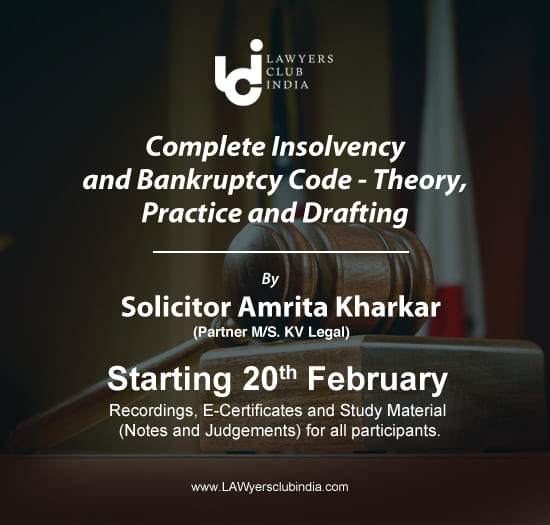KEY TAKEAWAYS
A notice was issued by the Supreme Court of India in an appeal against the National Company Law Appellate Tribunal (NCLAT) order which has held that the entries in the company’s balance sheet do not add up to an acknowledgment of liability in terms of Section 18 of the Limitation Act, 1963.
The purpose of this is to file an application for initiation of the corporate insolvency resolution process (CIRP) under the Insolvency and Bankruptcy Code, 2016.
The NCLAT observed that in order to assess the period of limitation for an application under Section 7 of the Insolvency and Bankruptcy Code, 2016 the right to sue occurs from the date of default.
Therefore, for this purpose date of classification as Non-performing assets (NPA) is important.
Click here to enroll masterclass on - The IBC - Theory, and Practice by Adv. Amrita Kharkar
INTRODUCTION
The Bench incorporating Justices R. F. Nariman, Hemant Gupta, and B. R. Gavai was hearing an appeal presented by Stressed Assets Stabilization Fund against the judgment given by 5 bench judge of NCLAT.
The judgment rejected reference by a three-member bench to revise the decision in V Padmakumar vs. Stressed Assets Stabilization Fund and another.
The debt in question was induced in March 2000, when a Corporate Debtor, Uthara Fashion Knitwear Limited made use of a loan of Rs. 600 lakh from the Industrial Development Bank of India (IDBI), the original lender. This loan was categorized as a Non-Performing Asset (NPA) on 29th May 2002.
An application for recovery was filed by IDBI in 2003. This was done under Section 19 of the Recovery of Debts and Bankruptcy, Insolvency Resolution, and Bankruptcy of Individuals and Partnership Firms Act, 1993 (RDB Act). The application was adjudged on 19th June 2009 and a recovery certificate was issued on 31st August 2009.
The debt was reflected in the balance sheet of the Corporate Debtor for the year ending 31st March 2012.
The bench was to answer the question if the application filed under Section 7 of the IBC in 2019 was barred by limitation. The bench answered this question in ‘yes’. It is important to take note that the application was filed by the Respondent to whom the debt was assigned by IDBI.
The judgment of Gaurav Hargovindbhai Dave vs. Asset Reconstruction Company Limited and another and V. Hotels Limited vs. Asset Reconstruction Company Limited was referred by the NCLAT.
Placing reliance on the Supreme Court decisions, NCLAT observed that the right to sue occurs from the date of default for purposes of computing the period of limitation for an application under Section 7 of the IBC.
FURTHER DETAILS
National Company Law Appellate Tribunal was formed by the Central Government of India under Section 410 of the Companies Act, 2013. It is responsible for hearing pleas from the orders of National Company Law Tribunals (NCLT).
NCLAT has been designated as appellate forum and powers are granted to it under Section 410 (a) and 410 (b) of Companies Act.
The Appellate tribunal has two benches throughout India. One at New Delhi and another at Chennai. The latter one is not yet notified to be functional. However the NCLT has 16 benches throughout India.
They were established to act as a uniform forum for deciding disputes related to working of companies where adjudicating it in a timely manner will help in smooth running of the economy.
RECENT DEVELOPMENTS IN IBC
Section 7 of the Insolvency and Bankruptcy Code, 2016 deals with initiation of corporate insolvency resolution process by financial creditor. Section 9 of the code provides for application of insolvency by an operational creditor and Section 10 of IBC deals with initiation of insolvency proceedings by a corporate applicant.
To make sure to prevent increased number of defaults by various enterprises during the Corona pandemic, the Government of India proposed to introduce Section 10A under the same code which will aim to suspend Section 7, Section 10 that deal with initiation of Corporate Insolvency Resolution Process (CIRP).
The suspension will bar the ability of a financial creditor, operational creditor and corporate applicant seeking beginning of the process for a period of six months but not exceeding twelve months. This suggestion was approved by the Union Cabinet and can be implemented in the future as an ordinance duly approved the President.
It has been noted that the said ordinance will protect borrowers from being dragged into insolvency.
CONCLUSION AND RECOMMENDATIONS
The law of limitation lays down the time within which a person can enforce their legal right. If a suit is filed after the expiry of that time it will be barred by limitation.
However, the law of limitation does not prevent defendant if he is presents a legitimate plea in his defence even though the suit is time-barred. In the case of Rullia Ram Hakim Rai vs. Fateh Singh it was held that limitation only bars action and it is only the recovery is time-barred. In another case of Shrimant Suryavanshi vs. Pralhad Bhairoba Suryavanshi, the Supreme Court noted that the Limitation act takes away plaintiff’s remedy to enforce his rights, but there is no restriction on the defendant to put forwards his defence.
The Act also keeps a check on the cases so that they do not dragged for over a long time.
However it has been observed that the IBC gives too much power to the creditors as the code allows them to initiate proceedings of insolvency. This power can be used in an abusive manner by the creditors. The amendment made is also a bit confusing and raises certain issues.
Join LAWyersClubIndia's network for daily News Updates, Judgment Summaries, Articles, Forum Threads, Online Law Courses, and MUCH MORE!!"
Tags :others










